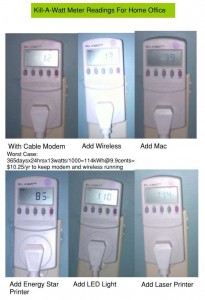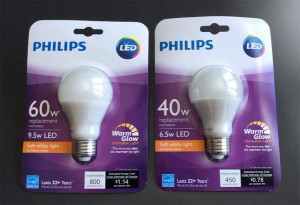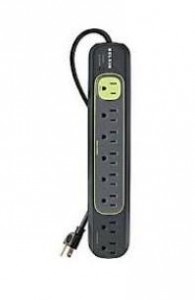At first I thought that the easiest sustainability project was to unplug appliances and other devices when not in use but then I thought about what is entailed in all that unplugging. You need to understand electricity and how it relates to your electric bill. You need to figure out how to unplug and you need to figure out what should stay on. So here goes:
What is a kilowatt anyway?
Watts are a power measure that rates energy flows just like gallons per minute measures water flow. Electric bills usually state usage in kilowatts or kWh. A kWh is 1,000 watts.
kWh is a consumerism measure – if you want to water the garden, you turn on the spigot and gallons of water flow out of the hose, when you get your water bill the cost is based on total gallons. – if you want to charge your cell phone, you plug it in and watts of energy flow out of the outlet. When you get your electric bill the total watts are billed in kWh.
Ex. A 60-watt lightbulb consumes electricity at a rate of 60 watts/hour or .06kWh/hour
Other terms you should know:
- 1000 watts equals 1 kilowatt (1kW)
- 1kW burning for one hour equals 1 kilowatt hour (1kWh)
- Your plug load is the amount of electricity demand you are paying for because of all the stuff you plug into outlets. These loads are growing by leaps and bounds. Think about it – you have a laptop, a cell phone, maybe an mp3 player, a modem, a router, a printer, maybe a fitness tracker – and all of these things need to be charged or used by being plugged in.
So how much energy does your stuff use?
Imagine you leave that 60 watt lightbulb burning all night – say for 10 hours.
- Calculate thus: (60/1000) x 10 = 0.6 kilowatt hours
What if you burned that light bulb every day – 365 days per year.
- Calculate thus: 0.6 kilowatt hours x 365 days = 219 kilowatt hours per year
Then multiply by your electric company’s rate to see how much it costs to burn the light.
My electric company charges $0.14/kWh
- Calculate how much you spent while you were sleeping with your eyes closed wanting it to be dark: 219 kWh x $0.14 = $30.66 per year
 Imagine, not that you would ever be so unwise, you left five 60 watt bulbs on for 10 hours every day…that would be $153 spent in a year …that is enough to fly round trip Philly-Orlando for that great vacation you have been wanting.
Imagine, not that you would ever be so unwise, you left five 60 watt bulbs on for 10 hours every day…that would be $153 spent in a year …that is enough to fly round trip Philly-Orlando for that great vacation you have been wanting.
So bulbs are easy. They actually tell you how much you are going to spend. Other stuff – like the cable modem – don’t tell you anything about how much energy they gobble up. There is a great gadget called a Kill-o-Watt that lets you measure the amount of electricity consumed by any object plugged into it. Get one and then plug in the cable modem for an hour. You will then know its kWh demand and how much you can save by turning it off. Have no fear, it comes back to life when you turn it back on.
Anyone can be an energy snoop?
Your energy snoop goal is to reduce your energy consumption to its lowest possible level. How?
Know what your plug load is by starting with an inventory:
- First, walk around with a pen and paper and write down everything that is plugged in. In my
 library I have the following plugged in: 2 floor lamps with 45 watt incandescent bulbs, a table lamp with a 25 watt incandescent bulb, a desk lamp with a 60 watt incandescent bulb, an Energy Star laptop, an Energy Star desktop computer, a printer and a cable modem.
library I have the following plugged in: 2 floor lamps with 45 watt incandescent bulbs, a table lamp with a 25 watt incandescent bulb, a desk lamp with a 60 watt incandescent bulb, an Energy Star laptop, an Energy Star desktop computer, a printer and a cable modem. - Then, figure out what items completely turn off when you turn them off so that you know that you have complete control over their use. For my list that includes the 2 floor lamps, a table lamp, and the desk lamp.
- Then figure out the energy draw from the remaining stuff. On my list the laptop, desktop computer, printer look like they are off when I turn them off. But nope. Each of mine, and yours may, have instant-on capability which means that a wee bit of electricity is being constantly used to keep the equipment warm. Figure out which of your items have instant-on.
- Finally the cable modem….right now I leave this on all the time except for when we leave for extended time like vacations. Then I turn it off.
- When walking around doing your inventory, look for little red lights and LED clocks. These things are called Energy Phantoms…there are others but these are the most visible and the most obnoxious energy hogs around. The LED clocks on every device from the microwave to your BOSE wave radio can be turned off – takes some doing but it is possible. The little red light often indicates that there is an instant-on feature in the equipment or appliance. Unplug it. It will come back on. It will take longer than a nano-second but it will come back on.
- Do this for all of your rooms.
If you are particularly nerdy:
- Get a Kill-o-Watt, measure demand and calculate your per room or per appliance costs. From this
 prioritize what plug loads to focus on. Note that many library systems have these little devices for check-out.
prioritize what plug loads to focus on. Note that many library systems have these little devices for check-out. - OR skip to the next step
Then develop and implement a plan of attack:
 Incandescent lightbulbs!!??? What was I thinking? First thing, change all of those for nice, warm light, LED bulbs. Instant savings no matter how long you keep them on.
Incandescent lightbulbs!!??? What was I thinking? First thing, change all of those for nice, warm light, LED bulbs. Instant savings no matter how long you keep them on.- Then make it a habit to turn off unneeded lights. If you need a nightlight, get an LED one from the hardware store – they are bright and consume very little energy. Turn off the landscape lighting unless you expect company.
- Then either unplug your communications and audio/visual equipment when not in use or plug them into power strips that can be shut off completely with the
 flick of a switch. This includes: TV’s, modems, desk-top computers, printers, VCR’s, DVD players, and gaming equipment. You can probably deal with a little delay when you push the on button.
flick of a switch. This includes: TV’s, modems, desk-top computers, printers, VCR’s, DVD players, and gaming equipment. You can probably deal with a little delay when you push the on button. - Then attach cell phone chargers to a power strip that automatically shuts off when the charge is complete. If chargers are plugged into the wall, always unplug them when they are not being used.
- Then figure out how to deal with the modem. At my house that items draws a lot of power. I am contemplating putting it on a timer off at 11pm on at 4 am that way folk still have communication and I get the satisfaction of it being off for at least part of the night.
Compare month to month and last year same month demand to see how you are doing. Repeat above steps.
